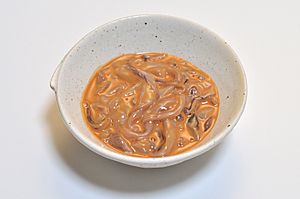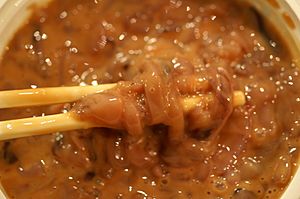Shiokara facts for kids
Shiokara (塩辛) lit. salty-spicy, is a food in Japanese cuisine made from various marine animals that consists of small pieces of meat in a brown viscous paste of the animal's heavily salted, fermented viscera.
The raw viscera are mixed with about 10% salt, 30% malted rice, packed in a closed container, and fermented for up to a month. Shiokara is sold in glass or plastic containers.
The flavor is similar in saltiness and fishiness to that of European cured anchovies, but with a different texture. One of the best-known chinmi ("rare tastes"), it is quite strong and is considered something of an acquired taste even for the native Japanese palate.
It was a valuable protein in post-war Japan because food was scarce and it did not require refrigeration. It continued to be eaten as a condiment for rice and in bars.
One method of enjoying it is to consume the serving at one gulp and to follow it with a shot of straight whisky. Some bars in Japan specialize in shiokara.
Some types of shiokara
- Ika no shiokara—from cuttlefish "squid", the most common variety
- Hotaruika no shiokara—from firefly squid
- Katsuo no shiokara—from skipjack tuna
- Kaki no shiokara—from oyster
- Uni no shiokara—from sea urchin roe
- Ami no shiokara—from Mysidacea, a krill-like crustacean
Some shiokara types have special names:
- ganzuke [ja] — from fiddler crab
- konowata [ja] — from sea cucumber
- mefun — from chum salmon
- uruka (shiokara) [ja] — from ayu
- shuto — from skipjack tuna (katsuo)
See also
 In Spanish: Shiokara para niños
In Spanish: Shiokara para niños



